
9.2 Heritage Conservation
Principle
Promote St. Albert’s rich history by conserving tangible and intangible parts of the city’s heritage.
Photo: Eric Schultz
Founded in 1861, St. Albert is the oldest non-fortified prairie community west of Winnipeg. The area that would become St. Albert is also the traditional home and meeting ground for many Indigenous peoples, including Cree, Saulteaux, Niitsitapi (Blackfoot), Métis, and Nakota Sioux peoples. St. Albert, which was founded as a Métis settlement by Father Albert Lacombe of the Missionary Oblates of Mary Immaculate (OMI), is rich with history and home to numerous historic and archaeological resources. The policies below support the identification, conservation, and protection of historic and archaeological resources in the city and manage the potential impacts of new development and redevelopment on these resources.
Levels of historic protection
Designation is a form of legal protection that helps to recognize and protect historic places. Historic places can be protected at the municipal, provincial, or national level. Alberta municipalities are empowered under the Historical Resources Act to designate historic places through the passage of a local bylaw. The bylaw legally protects historic resources from demolition or alterations that take away from their heritage value.
Policies
9.2.1.
Identify, conserve, and celebrate significant historic and archaeological resources in St. Albert, including, but not limited to, historic buildings, public spaces, landscapes, streetscapes, and districts.
9.2.2.
Identify, conserve, and celebrate intangible cultural heritage in St. Albert, including oral traditions, performing arts, social practices, rituals, festive events, and the knowledge and skills to produce traditional crafts.
9.2.3.
Encourage and promote heritage conservation through a variety of methods, including, but not limited to, the following:
- Supporting and promoting historic resource designation programs;
- Maintaining an inventory of potential municipal historic resources candidates;
- Collaborating with other levels of government, organizations, or individuals to protect historic resources; and
- Designing and implementing guidelines and regulations to minimize potentially adverse impacts of development on significant historic and archaeological resources.
9.2.4.
Support the conservation and enhancement of designated municipal historic resources and historic resources identified by other levels of government.
9.2.5.
Encourage statutory plans, design guidelines, and related studies to identify, respect, and conserve the heritage features and historic character of areas, districts, and individual properties.
9.2.6.
Require heritage assessments or studies, as deemed necessary by the City, where development is proposed on or abutting sites that contain provincially or municipally designated historic resources.
9.2.7.
Facilitate the review of heritage assessments, which include a Statement of Significance, for properties on the City’s, Province’s, or Canada’s Register of Historic Places, when reviewing planning and development applications, to protect their historic integrity and context.
9.2.8.
Facilitate and support using City-owned designated municipal historic resources for different uses than originally intended, provided that the redevelopment does not result in adverse impacts on its heritage value.
9.2.9.
Ensure restoration and conservation activities maintain the historical and architectural integrity of historic resources, as may be specified through a municipal or provincial heritage resource designation and in alignment with the Standards and Guidelines for the Conservation of Historic Places in Canada.
9.2.10.
Encourage new development or redevelopment that abuts historic resources to be compatible in terms of height, mass, setbacks, and overall architectural treatment.
9.2.11.
Encourage historic resources within new developments and redevelopment plans to align with the Standards and Guidelines for the Conservation of Historic Places in Canada.
9.2.12.
Explore ways to incorporate local history interpretive elements through public improvements in Neighbourhoods.
9.2.13.
Support appropriate changes to the Land Use Bylaw that encourage the retention, conservation, and adaptive reuse of historic resources.
9.2.14.
Encourage land use changes that increase the viability of retaining historic resources.
- - - - -
Previous:
Development & Programming
- - - - -
Next:
Payhonin Reconciliation
Related Pages
Last edited: July 12, 2021



